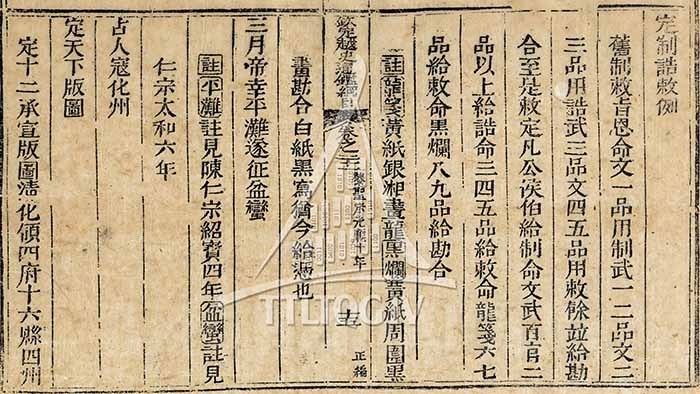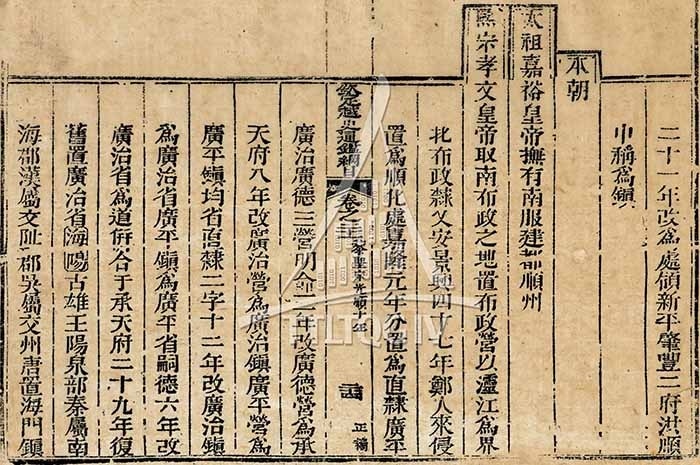Through woodblocks of the Nguyen dynasty, readers will understand more the formation as well as the development process of Hai Duong.

The 24th and 25th woodblocks of the 21st volume of the book Kham Dinh Viet Su Thong Giam Cuong Muc record the land of Hai Duong from the reigns of national founders Hung Kings to that of King Tran Thuan Tong
In the S-shaped country, Hai Duong is a land of extraordinary people with many contributions to the overall development of the nation. It is a land reminiscent of a heroic past from the dawn of national foundation to the process of national defense.
Back in history, the name and administrative boundaries of the present-day Hai Duong have been changed many times. Through woodblocks of the Nguyen dynasty – a Memory of the World currently being preserved at the National Archives Center IV in Da Lat city, Lam Dong province, readers will understand more the formation as well as the development process of Hai Duong.
According to historical documents, the land of Hai Duong was formed a long time ago.
The 24th and 25th woodblocks of the 21st volume of the book Kham Dinh Viet Su Thong Giam Cuong Muc (Imperially Ordered Mirror and Commentary on Vietnamese History) record the land of Hai Duong from the reigns of national founders Hung Kings to that of King Tran Thuan Tong as follows: "In Hung times, Hai Duong was Duong Tuyen bo (region)... The Dinh dynasty divided it into dao (province), so did the Early Le and Ly dynasties; the Tran dynasty renamed them lo: upper Hong Chau, lower Hong Chau, upper Nam Sach, and lower Nam Sach; in the 10th Quang Thai year, it was renamed Hai Dong tran (province)..."
After the victory against Ming invaders, in Mau Than year (1428), King Le Thai To divided the country into five dao, namely Tay, Dong, Bac, Nam, and Hai Tay, Hai Duong tran then belonged to Dong dao.
The 5th woodblock of the 15th volume of the book Kham Dinh Viet Su Thong Giam Cuong Muc also records: "The country was divided into five dao. Guardian troops were set up, Tong Quan (General Manager) and Hanh Khien (Deputy Prime Minister) were placed to keep records of the army and people... Big and small units looked after each other, juniors and seniors were bound to each other. Hanh Khien were also appointed to dao, keeping records of the army and people... Thuong Hong, Ha Hong, upper Nam Sach, and lower Nam Sach lo and An Bang tran belonged to Dong dao."
In the reign of King Le Thanh Tong, he divided administrative units in the country into 12 thua tuyen (province), including Nam Sach thua tuyen, in Binh Tuat year (1466). The 8th woodblock of the 20th volume of the book Kham Dinh Viet Su Thong Giam Cuong Muc records the event as follows: "At that time, the country was divided into 12 thua tuyen: 1) Thanh Hoa, 2) Nghe An, 3) Thuan Hoa, 4) Thien Truong, 5) Nam Sach, 6) Quoc Oai, 7) Bac Giang, 8) An Bang, 9) Hung Hoa, 10) Tuyen Quang, 11) Thai Nguyen, and 12) Lang Son."
Three years later (1469), the king ordered the fixing of the map of the country, including the 12 thua tuyen, and Nam Sach thua tuyen was renamed Hai Duong thua tuyen. The 15th and 16th woodblocks of the 21st volume of the book Kham Dinh Viet Su Thong Giam Cuong Muc records: "The king fixed the map of 12 thua tuyen... Nam Sach then was Hai Duong, governing four phu (a past administrative unit more important than a district) and 18 districts."
At that time, Hai Duong thua tuyen consisted of four phu and 18 districts. Specifically, Thuong Hong phu managed three districts of Duong Hao, Duong An, and Cam Giang; Ha Hong phu governed four districts of Gia Phuc, Tu Ky, Thanh Mien, and Vinh Lai; Nam Sach phu administered four districts of Thanh Ha, Thanh Lam, Tien Ninh, and Chi Linh; and Kinh Mon phu controlled seven districts of Giap Son, Dong Trieu, An Lao, Nghi Duong, Kim Thanh, Thuy Duong, and An Duong.
The name Hai Duong officially appeared from that point.

The 15th and 16th woodblocks of the 21st volume of the book Kham Dinh Viet Su Thong Giam Cuong Muc records King Le Thanh Tong's change of Nam Sach thua tuyen to Hai Duong thua tuyen in Ky Suu year (1469). Source: The National Archives Center IV
Regarding the meaning of the two words Hai and Duong, in Chinese language, Hai (海) is the sea and Duong (陽) is light or sunlight. Hai Duong was located to the east of Thang Long imperial city. The east is also the direction of the rising sun. Therefore, Hai Duong means "sunlight of the East Sea" or "light from the (eastern) coast."
King Le Thanh Tong changed Hai Duong thua tuyen to Hai Duong xu (region) in Canh Tuat year (1490) and a tran around the middle of Hong Thuan years (1509 – 1516).
The change of Hai Duong thua tuyen to Hai Duong xu was engraved on the 10th woodblock of the 24th volume of the book Kham Dinh Viet Su Thong Giam Cuong Muc as follows: "In April, it was summer. The country was divided into 13 xu. Previously, when the map was set, the country was divided into 12 thua tuyen. Then, the king placed three ty (department) of Do, Thua, and Hien in the old Chiem Thanh land in Quang Nam and determined the number of inhabitants with a larger territory divided into 13 xu, namely Thanh Hoa, Nghe An, Son Nam, Son Tay, Kinh Bac, Hai Duong, Thai Nguyen, Tuyen Quang, Hung Hoa, Lang Son, An Bang, Thuan Hoa, and Quang Nam and Trung Do phu. In the 13 xu, there were 52 phu, 178 districts, 50 chau (mountainous district), 20 huong (commune), 36 wards, 6,851 communes, 322 hamlets, 637 trang (estate), etc. There were Thu Ngu Kinh Luoc Su So (department established in a region to oversee the rule of border chieftains) in Nghe An, Thuan Hoa, An Bang, Hai Duong, Hung Hoa, Thai Nguyen, Lang Son, and Quang Nam."
Under the Mac dynasty, in Dinh Hoi year (1527), Mac Dang Dung named Hai Duong Duong Kinh. Thuan An phu was split from Kinh Bac and Khoai Chau, Tan Hung, Kien Xuong, and Thai Binh phu from Son Nam to be dependent on Duong Kinh.
The 17th volume of the book Dai Nam Nhat Thong Chi (Records of the Unification of Dai Nam) also records this event as follows: "The Mac dynasty set Nghi Duong as Duong Kinh and split Thuan An phu from Kinh Bac tran and Khoai Chau, Tan Hung, Kien Xuong, and Thai Binh phu from Son Nam tran to be dependent on Duong Kinh."
In the Later Le dynasty, King Le The Tong renamed it Hai Duong tran. In Tan Dau year (1741), King Le Hien Tong divided Hai Duong into four dao.
The 12th woodblock of the 39th volume of the book Kham Dinh Viet Su Thong Giam Cuong Muc records: "Tuan thu were appointed to four dao in Hai Duong. Since Hai Duong had been pacified, it was divided into four dao: Thuong Hong, Ha Hong, An Lao, and Dong Trieu with one tuan thu appointed to each of which to comfort the people in accordance with the territory."
THOM QUANG
------------
Part 2: Birth of "Hai Duong province" name